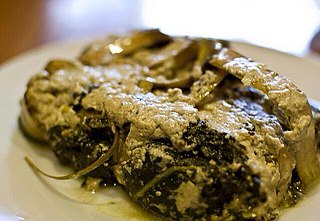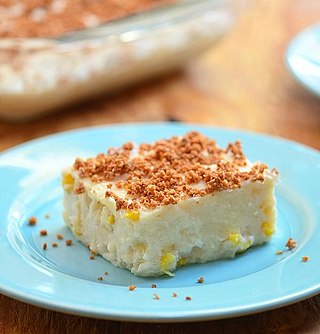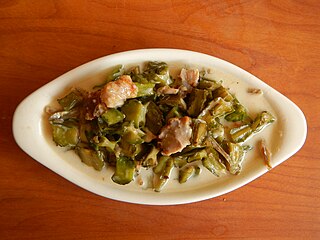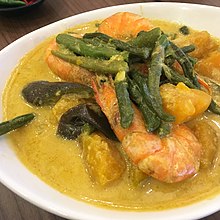
Ginataan, alternatively spelled guinataan, is a Filipino term which refers to food cooked with gatâ. Literally translated, ginataan means "done with coconut milk". Due to the general nature of the term, it can refer to a number of different dishes, each called ginataan, but distinct from one another.

Bicol Express, known natively in Bikol as sinilihan, is a popular Filipino dish which was popularized in the district of Malate, Manila but made in traditional Bicolano style. It is a stew made from long chili peppers or small chili peppers, coconut milk/coconut cream, shrimp paste or stockfish, onion, pork, ginger and garlic. The dish was termed by Laguna resident, Cely Kalaw, during a cooking competition in the 1970s in Malate, Manila. The name of the dish was inspired by the Bicol Express railway train that operated from Tutuban, Manila to Legazpi, Albay. The widely-known name for this dish in the Bicol Region of the Philippines was identified as gulay na may lada, which is currently one of the vegetarian variants of the Bicol Express dish. As time progressed, variants of the Bicol Express dish expanded with seafood, beef, pescatarian, vegetarian, vegan, and other versions. The preparations for these dishes vary according to the meat present within the dish. In terms of nutritional value, the original version of the Bicol Express dish is beneficial in protein but unhealthy in regards to its high levels of saturated fats and cholesterol. The dish has moved into food processing and commercial production so that it can be sold conveniently and stored for a longer period of time.

Laing, is a Filipino dish of shredded or whole taro leaves with meat or seafood cooked in thick coconut milk spiced with labuyo chili, lemongrass, garlic, shallots, ginger, and shrimp paste. It originates from the Bicol Region, where it is known simply as pinangat. Laing is also a type of ginataan, and thus may also be referred to as ginataang laing. Laing is commonly eaten as a vegetable side to complement meat or fish side dishes known as ulam in Filipino, which is normally paired with boiled white rice.

Maja blanca is a Filipino dessert with a gelatin-like consistency made primarily from coconut milk. Also known as coconut pudding, it is usually served during fiestas and during the holidays, especially Christmas.

Sinabawang gulay, usually anglicized as Filipino vegetable soup, is a Filipino vegetable soup made with leafy vegetables and various other vegetables in a broth seasoned with seafood stock or patis. The ingredients of the dish can vary widely. It is eaten on its own or over white rice.

Ginisang munggo is a Filipino savory mung bean soup. It is made with mung beans, garlic, tomatoes, onions, various vegetables, and patis. It is cooked with pork, tinapa, daing, or other seafood and meat. It is also commonly garnished with chicharon. The name means "sauteed mung bean", though the dish ends up being a soup. The name is in reference to the first step of the cooking process where the spices and the secondary ingredients are sauteed before water and the mung beans are added.

Gising-gising, also known as ginataang sigarilyas, is a spicy Filipino vegetable soup or stew originating from the provinces of Nueva Ecija and Pampanga in the Philippines. It is traditionally made with chopped winged beans, and coconut milk spiced with labuyo chili, garlic, onions, and bagoong alamang. The name literally means "wake up, wake up". It can be eaten alone, on top of rice, or as a side dish to grilled meat dishes. It is a type of ginataan.

Okoy or ukoy, are Filipino crispy deep-fried fritters made with glutinous rice batter, unshelled small shrimp, and various vegetables, including calabaza, sweet potato, cassava, mung bean sprouts, scallions and julienned carrots, onions, and green papaya. They are traditionally served with vinegar-based dipping sauces. They are eaten on their own or with white rice. They are popular for breakfast, snacks, or appetizers. Okoy are sometimes dyed bright orange with achuete seeds.

Ginataang langka, is a Filipino vegetable stew made from unripe jackfruit in coconut milk and spices. The dish includes a wide variety of secondary ingredients like seafood, meat, and other vegetables. The dish also commonly adds bagoong alamang and may be spiced with chilis or soured with vinegar. Notable variants of the dish are ginataang kamansi and ginataang rimas which use breadnut and breadfruit, respectively. Ginataang langka is a type of ginataan.

Ginataang hipon is a Filipino seafood soup made from shrimp in coconut milk and spices. It differs from other types of ginataan, in that it does not use vegetables. It is a type of ginataan. Variants of the dish includes ginataang curacha and ginataang sugpo, which use spanner crabs and prawn in place of shrimp, respectively.
Curacha Alavar, sometimes referred to as curacha con salsa Alavar in Chavacano a Spanish-based creole language, is a Filipino dish made from spanner crabs (curacha), garlic, ginger, salt, and Alavar sauce. The key ingredient is the Alavar sauce, a secret blend of coconut milk, taba ng talangka, and various spices.

Sinantolan, also known as ginataang santol or gulay na santol, is a Filipino dish made with grated santol fruit rinds, siling haba, shrimp paste, onion, garlic, and coconut cream. Meat or seafood are also commonly added, and a spicy version adds labuyo chilis. It originates from Southern Luzon, particularly from the Quezon, Laguna, and Bicol regions. It is a type of ginataan.

Ginataang ampalaya, is a Filipino vegetable stew made from bitter melon and tinapa in coconut milk, bagoong alamang, and spices. The dish can also be made with pork or shrimp and other vegetables. The dish is characteristically savory and slightly bitter due to the ingredients used. It is a type of ginataan.

Ginataang munggo, also known as lelut balatung in pampanga or tinutungang munggo, is a Filipino glutinous rice gruel dessert with toasted mung beans, coconut milk, and sugar. It is typically flavored with vanilla or pandan leaves. Corn and fruits like jackfruit or banana may also be added. It is a type of lugaw and ginataan.

Ginataang isda is a Filipino fish stew made from fish and leafy vegetables in coconut milk with garlic, ginger, onion, patis or bagoong alamang, and salt and pepper. It is a type of ginataan. A common version of the dish, known as ginataang paksiw na isda or paksiw na isda sa gata, is additionally soured with vinegar. Ginataang isda is a type of ginataan.

Ginataang manok is a Filipino chicken soup made from chicken in coconut milk with green papaya and other vegetables, garlic, ginger, onion, patis or bagoong alamang, and salt and pepper. It is a type of ginataan. A common variant of the dish adds curry powder or non-native Indian spices and is known as Filipino chicken curry.

Ginataang labong or ginataang tambo is a Filipino vegetable stew made from bamboo shoots in coconut milk and spices with seafood or meat. It is the most common way of preparing bamboo shoots in Philippine cuisine. Ginataang ubod is a variant of the dish made with heart of palm but is otherwise prepared identically. It is a type of ginataan.

Sinanglay is a Filipino dish made from stuffed fish wrapped in leafy vegetables and lemongrass or pandan leaves cooked in a spicy coconut milk sauce. It is a type of ginataan and originates from the Bicol Region.


















